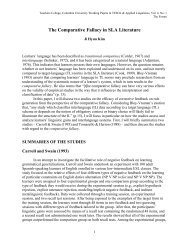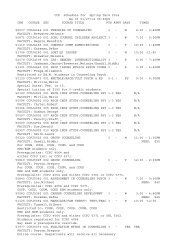UNICEF Mongolia - Teachers College Columbia University
UNICEF Mongolia - Teachers College Columbia University
UNICEF Mongolia - Teachers College Columbia University
Create successful ePaper yourself
Turn your PDF publications into a flip-book with our unique Google optimized e-Paper software.
CHAPTER 2: THE TEACHING WORKFORCE<br />
larger schools employ office clerks and typists. 8 To control hiring, there exist centrally established<br />
regulaons; for example, each school must hire a physician for every 1,000 students.<br />
• Over eighty percent of the school staff is female and yet there is no gender parity for the posion<br />
of school principal. This means, women are under-represented as senior school administrators<br />
(notably as school principals), as compared to lower administrave or teaching posions.<br />
2.2. GENDER, TEACHING EXPERIENCE AND QUALIFICATION<br />
Gender: The teaching profession is predominantly female. As Table 6 demonstrates, women comprise<br />
almost 96 percent of the teaching workforce in primary schools. The proporon of female teachers drops<br />
in lower and upper secondary school but women nevertheless represent three-quarters of all teachers<br />
at post-primary level.<br />
Teaching Experience: The teaching workforce is remarkably young: 30.6 percent of all teachers have<br />
worked for five years or less in schools. In September 2010, 1,171 new teachers were hired. In contrast<br />
to this large group of new and young teachers, only 14.4 percent or 3,809 teachers have more than 25<br />
years of work experience. The rejuvenaon of the teaching workforce is predominantly a result of the<br />
expansion of general educaon, first from 10 to 11 years in 2004/05 and then from 11 to 12 years of<br />
schooling in 2008/09. The expansion required the employment of a greater number of teachers, in great<br />
part recruited from pre-service teacher educaon graduates.<br />
1<br />
2<br />
3<br />
4<br />
5<br />
6<br />
Qualificaons: According to stascal informaon from MECS, only 175 teachers out of a total of 26,358<br />
teachers are unqualified teachers. This amounts to 0.7 percent of the teaching workforce. There has been<br />
in a significant boom in teacher educaon studies over the past ten years. There are currently numerous<br />
public and private universies that provide diplomas and bachelor’s degrees. A few of them, however,<br />
are diploma mills or issue degrees with lile recognion in the market place. Figure 5 demonstrates that<br />
the number of qualified teachers increased over the past 15 years from 87.9 percent to 99.3 percent. In<br />
the same period, the number of enrollments in higher educaon quadrupled from 44,088 to 170,126.<br />
The eradicaon of the category “unqualified teachers”—currently at a low of 0.7 percent—does not<br />
necessarily imply that the quality of teachers has improved. There is significant public concern about<br />
the large number of diplomas and degrees that are considered of limited value in the labor market, yet<br />
cost a lot to obtain. With the excepon of the large teacher educaon programs, mostly based at public<br />
universies, there is no direct link between qualificaon and the quality of teachers. The high number of<br />
stascally qualified teachers masks the reality that many so-called qualified teachers have obtained a<br />
second-class pre-service teacher educaon.<br />
TEACHERS IN MONGOLIA: AN EMPIRICAL STUDY ON RECRUITMENT INTO TEACHING,<br />
PROFESSIONAL DEVELOPMENT, AND RETENTION OF TEACHERS<br />
8 In the academic year 2010-2011, there were 669 accountants, 660 inventory clerks and dormitory administrators, and 362 office<br />
clerks and typists (Stascal Abstract, 2011).<br />
33


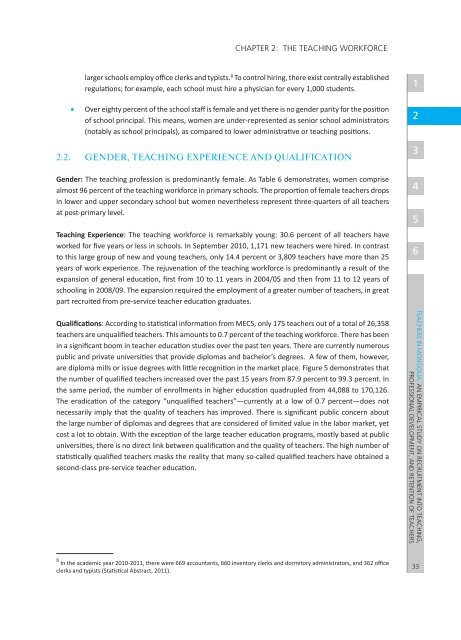
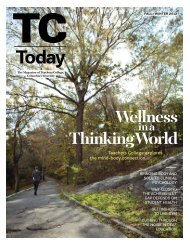

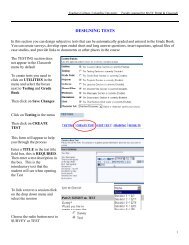


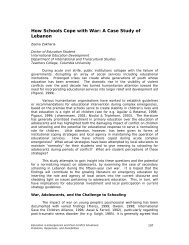
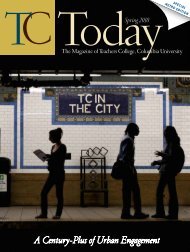
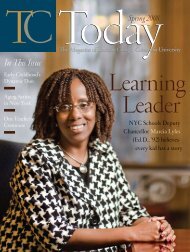



![TC Tod[...].pdf - Teachers College Columbia University](https://img.yumpu.com/27074883/1/190x252/tc-todpdf-teachers-college-columbia-university.jpg?quality=85)

